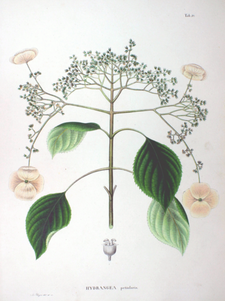Hydrangea anomala
| subsp. var. | ||||||||||||||||||||||||||||||||||||||||||||||||||||||||
|---|---|---|---|---|---|---|---|---|---|---|---|---|---|---|---|---|---|---|---|---|---|---|---|---|---|---|---|---|---|---|---|---|---|---|---|---|---|---|---|---|---|---|---|---|---|---|---|---|---|---|---|---|---|---|---|---|

|
|
| ||||||||||||||||||||||||||||||||||||||||||||||||||||||
| ||||||||||||||||||||||||||||||||||||||||||||||||||||||||
| Standard Cyclopedia of Horticulture |
|---|
|
Hydrangea anomala, Don (H. altissima, Wall.). High climbing, glabrous: lvs. ovate to elliptic-ovate or ovate- oblong, broadly cuneate at the base, denticulate- serrate, 2—4 in. long; petioles ¾ -2 in. long: cymes loose, puberulous, 4-6 in. across; stamens 10; sterile fls. few or sometimes wanting, about 1 in. across, with suborbicular sepals. July. W. China, Himalayas. Wallich, Tent. Flor. Nepal. 50.
|
| Hydrangea anomala {{{status}}} Fossil range: {{{fossil_range}}}
| ||||||||||||||||||||||||||||||||||||||||||||||||||||||||||||||||||
|---|---|---|---|---|---|---|---|---|---|---|---|---|---|---|---|---|---|---|---|---|---|---|---|---|---|---|---|---|---|---|---|---|---|---|---|---|---|---|---|---|---|---|---|---|---|---|---|---|---|---|---|---|---|---|---|---|---|---|---|---|---|---|---|---|---|---|
 Hydrangea anomala ssp petiolaris | ||||||||||||||||||||||||||||||||||||||||||||||||||||||||||||||||||
| Plant Info | ||||||||||||||||||||||||||||||||||||||||||||||||||||||||||||||||||
| ||||||||||||||||||||||||||||||||||||||||||||||||||||||||||||||||||
| Scientific classification | ||||||||||||||||||||||||||||||||||||||||||||||||||||||||||||||||||
| ||||||||||||||||||||||||||||||||||||||||||||||||||||||||||||||||||
| [[{{{diversity_link}}}|Diversity]] | ||||||||||||||||||||||||||||||||||||||||||||||||||||||||||||||||||
| {{{diversity}}} | ||||||||||||||||||||||||||||||||||||||||||||||||||||||||||||||||||
| Binomial name | ||||||||||||||||||||||||||||||||||||||||||||||||||||||||||||||||||
| Hydrangea anomala D.Don | ||||||||||||||||||||||||||||||||||||||||||||||||||||||||||||||||||
| Trinomial name | ||||||||||||||||||||||||||||||||||||||||||||||||||||||||||||||||||
| {{{trinomial}}} | ||||||||||||||||||||||||||||||||||||||||||||||||||||||||||||||||||
| Type Species | ||||||||||||||||||||||||||||||||||||||||||||||||||||||||||||||||||
| {{{type_species}}} | ||||||||||||||||||||||||||||||||||||||||||||||||||||||||||||||||||
| {{{subdivision_ranks}}} | ||||||||||||||||||||||||||||||||||||||||||||||||||||||||||||||||||
| [[Image:{{{range_map}}}|{{{range_map_width}}}|]] | ||||||||||||||||||||||||||||||||||||||||||||||||||||||||||||||||||
| Synonyms | ||||||||||||||||||||||||||||||||||||||||||||||||||||||||||||||||||
| {{{synonyms}}} |
Hydrangea anomala is a species of hydrangea native to the woodlands of the Himalaya, southern and central China and northern Myanmar.
It is a woody climbing plant, growing to 12 m height up trees or rock faces, climbing by means of small aerial roots on the stems. The leaves are deciduous, ovate, 7-13 cm long and 4-10 cm broad, with a heart-shaped base, coarsely serrated margin and acute apex. The flowers are, produced in flat corymbs 5-15 cm diameter in mid-summer; each corymb includes a small number of peripheral sterile white flowers 2-3.5 cm across, and numerous small, creamy-white fertile flowers 1-2 mm diameter. The fruit is a dry urn-shaped capsule 3-5 mm diameter containing several small winged seeds.
The closely related Hydrangea petiolaris from eastern Siberia, Japan, and Korea, is sometimes treated as a subspecies of H. anomala; it differs in growing larger (to 20 m) and flower corymbs up to 25 cm diameter. The common name Climbing hydrangea is applied to both species.
Cultivation and uses
Hydrangea anomala is grown as an ornamental plant, being popular due to its relatively non-aggressive nature.